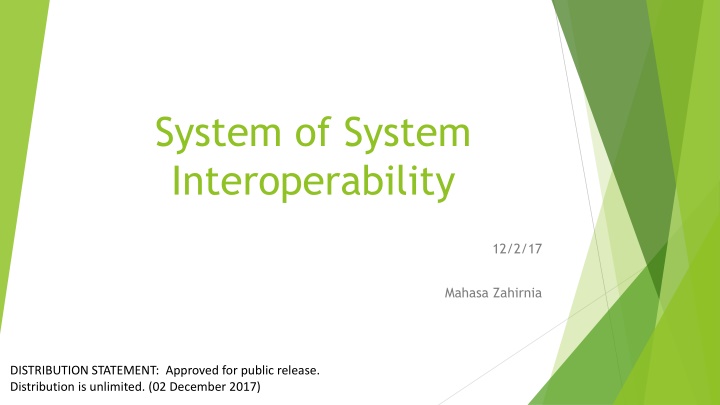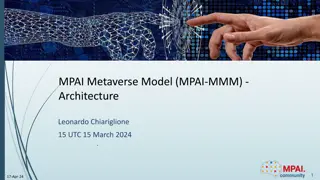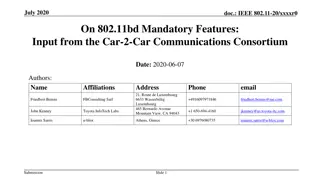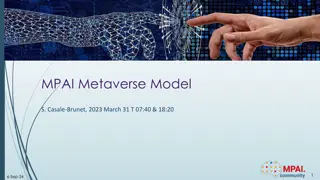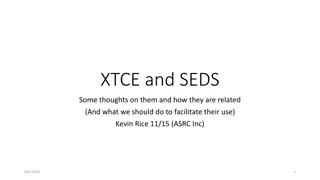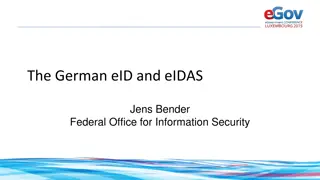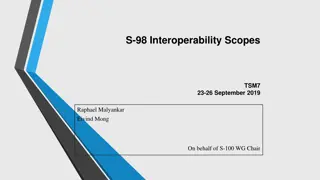System of System Interoperability Overview
These slides cover the design and development process of System of Systems, including key elements of interoperability, interface design, and programmatic activities. Learn about System of Systems Engineering, process start to finish, partnering with industry for success, and more.
Download Presentation

Please find below an Image/Link to download the presentation.
The content on the website is provided AS IS for your information and personal use only. It may not be sold, licensed, or shared on other websites without obtaining consent from the author.If you encounter any issues during the download, it is possible that the publisher has removed the file from their server.
You are allowed to download the files provided on this website for personal or commercial use, subject to the condition that they are used lawfully. All files are the property of their respective owners.
The content on the website is provided AS IS for your information and personal use only. It may not be sold, licensed, or shared on other websites without obtaining consent from the author.
E N D
Presentation Transcript
System of System Interoperability 12/2/17 Mahasa Zahirnia DISTRIBUTION STATEMENT: Approved for public release. Distribution is unlimited. (02 December 2017)
Agenda Organization Maturity Level Purpose What is System of System What are Requirements of Interoperability System Engineering Process Interoperability Development Elicitation Analysis Specification Interface Design Document Validation Partnering with Industry for Program Success Building Requirement throughout Engineering Process Engineering process within JCID Organizational Interoperability What is Interoperability Levels of Information System Interoperability Program Activities to Achieve Interoperability Conclusion and Improvement Area 2
Purpose The purpose of these slides are to describe: System of System design and development process Interoperability definition and critical components to develop a mature interface design Programmatic and structural activates as it relates to interoperability 3
What is System of System Engineering A system of systems (SoS) is 'a collection of systems, each capable of independent operation, that interoperate together to achieve additional desired overall system success 4
System Engineering Process Start with needs Finish with Tests Warfighter Requirements ICDs, CDDs, and CPDs Acceptance Tests Product Validation System Requirements Architectural Specification Regulations Performance Requirements System Tests Integration Tests Conforms to Design Specifications Standards Unit Tests Component Qualification Conforms to 5
Partnering with Industry for Program Success Start with needs Finish with Tests Warfighter Requirements ICDs, CDDs, and CPDs Acceptance Tests Product Validation System Requirements Architectural Specification Regulations Performance Requirements System Tests Integration Tests Conforms to Government- Industry Partnership Design Specifications Standards Unit Tests Component Qualification Conforms to 6
Building Requirements throughout the Engineering process User Requirements Technical Requirements Test Cases Design Test Plan System & Interface Specifications Performance Requirements Document (PRD) Capabilities Document 7
Engineering stages within the JCID Process Sustainment A B C (Program Initiation) System Integration System LRIP Full-Rate Production Demonstration Disposal Concept Decision FRP Decision Review Design Readiness Review IOTE Operations & Support Concept Refinement Refinement Technology Development Concept System Development & Demonstration Production & Deployment Operation Production 1st Articale Architecture Design Test Development 8
What is Interoperability As per IEEE and DoD interoperability can be defined as: The ability for two or more systems or elements to exchange information and to use the information that have been exchanged The capability for unit of equipment to work together to do useful functions The ability of system, units or forces to provide services to and accept services from other systems, units, or forces and to use the services so exchanged 9
Level of Information System Interoperability (LISI) 10
Level of Interoperability Defined Level 0 Isolated interoperability in a manual environment between stand-alone systems: Interoperability at this level consists of the manual extraction and integration of data from multiple systems. This is sometimes called sneaker-net. Level 1 Connected interoperability in a peer-to-peer environment: This relies on electronic links with some form of simple electronic exchange of data. Simple, homogeneous data types, such as voice, text email, and graphics (e.g., Graphic Interface Format files) are shared. There is little capacity to fuse information. Level 2 Functional interoperability in a distributed environment: Systems reside on local area networks that allow data to be passed from system to system. This level provides for increasingly complex media exchanges. Logical data models are shared across systems. Data is generally heterogeneous-containing information from many simple formats fused together (e.g., images with annotations). Level 3 Domain based interoperability in an integrated environment. Systems are connected via wide area networks. Information is exchanged between independent applications using shared domain-based data models. This level enables common business rules and processes as well as direct database-to-database interactions. It also supports group collaboration on fused information. Level 4 Enterprise-based interoperability in a universal environment: Systems are capable of using a global information space across multiple domains. Multiple users can access complex data simultaneously. Data and applications are fully shared and distributed. Advanced forms of collaboration are possible. Data has a common interpretation regardless of format. 11
Organization Maturity Level The Maturity of the organization will dictate the level of interoperability of the product/project. The more unified and collaborative the organization the more the system will be designed at the highest level of interoperability. 12
What are the Requirements of Interoperability Define what not how (i.e. implementation free) Constitute an agreement between the customer and the developer Are Concise and Explicit (i.e. unambiguous and clear) Clear definition of each interface element Quantifiable Verifiable (i.e. I can test them) 13
Interoperability Development Interoperability Process Components Interface Development Interface Management Design Evaluating impact of change Evaluating impact of change Tracing work products Elicitation Specification Tracking requirements status Analysis Documenting the Project Plan Verification Validation Documenting Processes Full Scope Best Practices Entry at any point Facilitation & Leadership 14
Elicitation The elicitation procedure consists of five steps: Identify relevant interface requirement sources Ask them appropriate questions to understand their needs Look for implications, inconsistencies and unresolved issue in gathering information Confirm your understanding of interface requirements with the users Synthesize appropriate statement of the requirements (i.e. ConOps, ICD, CDD) 15
Analysis Analysis is the process of breaking down interface requirements into tangible, qualifiedly sub requirements such that specifications can be written. The three major goals are: Achieve an agreement among developers and warfighther Provide a basis for interface design Provide a basis for Verification and Validation of the interface System Subsystem A Subsystem B Subsystem B Component A Component B Component Z 16
Specification Interface Specification is the documentation of the interface requirements developed through analysis. The system will be built or modified and tested to comply with interface specification and other specification Two other major specification are hardware, software System Specifcation Hardware Specifcation Interface Specification Software Specication Interface Design Document Software Test Plan Software Design Spec Software Test Procedures Software Code 17
Interface Design Document The Interface Design Document shall have the following elements Interface Diagram Purpose of each interface Complete description of each data element Project unique ID for each element Brief Description The configuration item that is the source of the data element The configuration item that is the user of the data element The units of measurement Limit/range Accuracy required Precision of the resolution required Refresh frequency Legality checks Data type (integer, ASCII, real, ) Data format Priority Security 18
Validation Interface Verification and validation is a set of actions used to check the correctness of any element of the interface Product C Segment A Product A Segment A Product C Segment B Product A Segment B Product C Segment C Product C Segment A Product C Segment D Product B Segment A 19
Organizational Interoperability Programmatic: Interoperability between different program office Constructive: Interoperability between the organizations that are responsible for the construction and maintenance of the system Operational: Interoperability between the system Program 1 Program 2 Program Management Program Management System Construction System Construction System Operation System Operation 20
Program Activities to Achieve Interoperability Program responsibilities is defined as continuous involvement of stakeholders that define and/or utilize the system focusing on Interoperability 21
Conclusion and Improvement Areas Program ownership and partnership with other programs A barrier to interoperability is a lack of centralized or coordinated ownership of the problem. Shortsighted decisions and lack of requirement decomposition will promote a single system s view at the expense of other systems Consistent and detailed structures for enforcing interoperability is required for program success Legacy inoperability will continue to grow and systems will become outdated without a complete overhaul of the program design
Resources Department of Justice System Development Life Cycle Guidance, Chapter 6: www.usdoj.gov/jmd/irm/lifecycle/table.htm Program Manager s Guide for Management Software,0.6, 29 June 2001 Chapter 6: www.geia.org/sstc/G47/SW MgmtGuide%20Rev%/200.4.doc Requirements Generation System Joint Chief of Staff: www.jsc.mil/jsec3/EMCSLSA/stdlib/cd/added/3170_01.pdf 23
